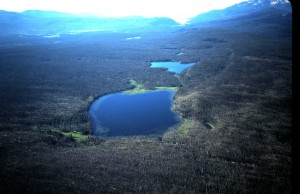Beula Lake
Beula Lake
See that lake in the foreground of the “lookin’ south” areal picture above? That’s Beula Lake in the southwest area of Yellowstone National Park. It is also one of the Park’s largest lake (a bit over 100 acres) hosting Yellowstone cutthroat trout as the sole salmonid. You cannot say that about larger Park lakes such as Yellowstone and Heart because they also host lake trout. Trout Lake also hosts cutthroat-rainbow hybrids. If I were to take a fly-fisher asking to catch cutthroat trout somewhere, especially in a back country setting, Beula Lake would be a top candidate for catching one.
Again, let’s look at the picture above. The trail head to Beula Lake is on the Ashton-Flagg Road at the east end of Grassy Lake Reservoir. You can see the trail’s trace towards the right through the skinny jackpine forest in the above picture. It ends at the southwest corner of the lake, a distance of 2.75 miles. The first half mile from the trail head is uphill, but the rest is flat until you drop about 100 yards to the lake. There is a way to avoid this uphill pitch, but it is best described here in the shop. That’s Fall River coming into the southeast side of the lake. Fall River exits the lake at the northwest corner cascading down to flow through the first of stair-step meadows on exiting the Park and on into Idaho. The elevation here is almost 7500 feet, so being in reasonable shape for the walk is advised. There are three primitive campsites along the west shore of the lake. Any one of these can be used for an overnighter through the Park’s back country reservation system, but a day trip is totally practical. Now let’s talk fishing.
The season here begins as soon as the USFS opens the Ashton-Flagg Road to traffic. That means after the road is dried. This is big snow country, so opening usually happens late in June. Much of Beula can be fished from the shoreline. Just follow the fisherman trail around the lake to one of the several locations with shallow wading and allowing back cast room. Waders help, but are not necessary. Beula cutts are not particular; any of your favorite small or medium sized bead head nymph or leech patterns will attract cutts averaging 10-16 inches, but ranging to a bit over 20 inches. A floating line and nine foot leader with 3-4X tippet is all that is needed for presentation. Damselfly action can be expected by the end of June, and speckled duns begin emerging in July. So life cycle patterns for these two insect types work well any time, and the gulper fishing when they emerge can be terrific. I’d mentioned wading as being effective for Beula, but if you are in good enough shape to pack a float tube in, you will have even better fishing. Insulated waders may be best for the water temps in the high fifties in degrees Fahrenheit. Get in front of the lily pad beds and pitch flies back towards the lilys or go to the inlet for non-stop action. Thirty to forty fish days are common this way. Again, going to the picture above, you can see Hering Lake just to the south of Beula. You will need a float tube to fish Hering effectively, but your reward can be cutthroats ranging to over four pounds. But that is not every year. Hering is not as hospitable as Beula, and trout get trapped in it when water connecting the two lakes recedes in springtime. Some years only a few fish get trapped in Hering, but competition is lower here , so they grow to larger sizes. By September another food form is important on these two lakes. That would be from the ant swarms that frequent the area. When they fall in good numbers onto the lake surfaces, trout key on them with enthusiasm. Around the end of September to the first of October the season begins ending here. That is mainly because of weather. Rain or snow storms can make the Ashton-Flagg Road tough for other than four-wheel drive vehicles, but when blue bird days extend into October, Beula (and Hering) can be spectacular fishing. Just keep an eye on the sky for a change in the weather. Any time you venture here bring potable water, ultra violet protection, and a reliable raincoat. You will be for a unique and great back country fly-fishing experience.

